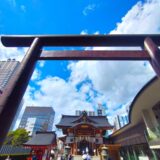目次
- 【Gokoku-ji Temple summary】
- 【Gokoku-ji Temple temple gate of the Nio】
- 【Gokoku-ji Temple Furo-mon Gate】
- 【Gokoku-ji Temple Gokokuji Buddha】
- 【Gokoku-ji Temple Main Hall (Kannon-do)】
- 【Gokoku-ji Temple two-storied pagoda (with a square base, pent roof and a round top)】
- 【Gokoku-ji Temple Asama Shrine mound covering reverently buried old fujis】
- 【Gokoku-ji Temple GOSHUIN】
- 【Gokoku-ji Temple Nearby attractions】
- 【Gokoku-ji Temple Access】
- Manager’s Comments
- Gokoku-ji Temple
【Gokoku-ji Temple summary】
Gokoku-ji Temple is the head temple of the Toyoyama School of Shingon Buddhism. *The head temple is Hase-ji Temple in Nara Prefecture. It was built in 1681 by Tsunayoshi Tokugawa, the fifth shogun, for his mother, Keishoin. Therefore, it was a temple for the Tokugawa Shogunate until the Meiji Restoration. After the Meiji Restoration, the temple lost the backing of the Shogunate, and as a result, it faced economic hardship. Currently, the Imperial Household Agency manages the eastern half of the grounds, which is about 50,000 tsubo, where members of the Imperial Family other than the Emperor and Empress are buried when they die. The western half, 5,000 tsubo, is an army cemetery.
The principal deity is Nyoirin Kanzeon Bosatsu
【Gokoku-ji Temple temple gate of the Nio】
![Gokoku-ji Temple [Tokyo] DSC 1242 1024x768 - Gokoku-ji Temple [Tokyo]](https://japan-shrine.info/wp-content/uploads/DSC_1242-1024x768.jpg)
It is said to have been built in the early Showa period (early 20th century), with a statue of Nio and a statue of Niten in the back.
【Gokoku-ji Temple Furo-mon Gate】
![Gokoku-ji Temple [Tokyo] DSC 1214 1024x768 - Gokoku-ji Temple [Tokyo]](https://japan-shrine.info/wp-content/uploads/DSC_1214-1024x768.jpg)
Further ahead is the Furoi-mon Gate surrounded by magnificent plantings. After passing through this gate, you will see the main hall in front of you and the Great Buddha to your right.
【Gokoku-ji Temple Gokokuji Buddha】
![Gokoku-ji Temple [Tokyo] DSC 1223 1024x768 - Gokoku-ji Temple [Tokyo]](https://japan-shrine.info/wp-content/uploads/DSC_1223-1024x768.jpg)
The Daibutsu (Great Buddha) is on the right as soon as you pass through the temple gate. This statue was moved from the Gojiin Temple, which was a branch of Mt. Tsukuba Daigongen (present-day Tsukuba Shrine), during the Meiji period (1868-1912) when the government decided to abolish Buddhism.
【Gokoku-ji Temple Main Hall (Kannon-do)】
![Gokoku-ji Temple [Tokyo] DSC 1219 2 1024x768 - Gokoku-ji Temple [Tokyo]](https://japan-shrine.info/wp-content/uploads/DSC_1219-2-1024x768.jpg)
The main hall was built in 1697 and miraculously survived the Great Kanto Earthquake and air raids. It is wonderful that the architecture from the early Edo period remains. It is now designated as a National Important Cultural Property.
Although photography is prohibited, visitors can enter the main hall to view the ceiling paintings and sculptures. The temple’s distinctive aroma is nostalgic and calming. The main deity, Nyoirin Kannon, is a hidden Buddha and is usually not open to the public, but it is unveiled on the 18th of every month.
【Gokoku-ji Temple two-storied pagoda (with a square base, pent roof and a round top)】
![Gokoku-ji Temple [Tokyo] DSC 1228 2 1024x768 - Gokoku-ji Temple [Tokyo]](https://japan-shrine.info/wp-content/uploads/DSC_1228-2-1024x768.jpg)
This pagoda at Gokokuji Temple was built as a copy of the Daboto (National Treasure) pagoda at Ishiyamaji Temple. Next to the pagoda is a tea ceremony room with a row of students.
【Gokoku-ji Temple Asama Shrine mound covering reverently buried old fujis】
![Gokoku-ji Temple [Tokyo] DSC 1233 1024x768 - Gokoku-ji Temple [Tokyo]](https://japan-shrine.info/wp-content/uploads/DSC_1233-1024x768.jpg)
There is a torii gate diagonally in front on the right. I hesitate a little to enter…
![Gokoku-ji Temple [Tokyo] DSC 1235 1024x768 - Gokoku-ji Temple [Tokyo]](https://japan-shrine.info/wp-content/uploads/DSC_1235-1024x768.jpg)
After passing through the torii gate, I found Fuji-zuka, a mound of lava brought from the real Mt. Fuji, and climbing it is said to bring the same benefits as climbing the real Mt.
![Gokoku-ji Temple [Tokyo] DSC 1236 2 1024x768 - Gokoku-ji Temple [Tokyo]](https://japan-shrine.info/wp-content/uploads/DSC_1236-2-1024x768.jpg)
At the top of the mountain was Sengen Shrine, a shrine of the Fuji faith that worships Mt.
There are Fuji mounds like this all over Japan, and in Tokyo, there is one at Shinagawa Shrine and Hatomori-Hachiman Shrine.
【Gokoku-ji Temple GOSHUIN】
![Gokoku-ji Temple [Tokyo] 2024 10 24 13 57 Office Lens 741x1024 - Gokoku-ji Temple [Tokyo]](https://japan-shrine.info/wp-content/uploads/2024_10_24-13_57-Office-Lens-741x1024.jpg)
![Gokoku-ji Temple [Tokyo] 2024 10 24 14 01 Office Lens 691x1024 - Gokoku-ji Temple [Tokyo]](https://japan-shrine.info/wp-content/uploads/2024_10_24-14_01-Office-Lens-691x1024.jpg)
【Gokoku-ji Temple Nearby attractions】
Hotel Chinzan-so, Tokyo Cathedral St. Mary’s Cathedral, Higo Hosokawa Garden
【Gokoku-ji Temple Access】
Manager’s Comments
I had the impression that there were not many worshippers since the area was not a tourist attraction. The site is relatively spacious, and there is no needlessly gaudy atmosphere, so I was able to visit the shrine in peace and quiet. If you like shrines and temples, I think you will be highly satisfied. I hope this is one of the temples in Tokyo that will remain for a long time. If you are staying at Chinzan-so, you can come here on foot and take a walk.
 Tour of Japanese shrines and temples
Tour of Japanese shrines and temples 

![Gokoku-ji Temple [Tokyo] DSC 0630 520x300 - Gokoku-ji Temple [Tokyo]](https://japan-shrine.info/wp-content/uploads/DSC_0630-520x300.jpg)
![Gokoku-ji Temple [Tokyo] DSC 1773 520x300 - Gokoku-ji Temple [Tokyo]](https://japan-shrine.info/wp-content/uploads/DSC_1773-520x300.jpg)
![Gokoku-ji Temple [Tokyo] DSC 1876 2 520x300 - Gokoku-ji Temple [Tokyo]](https://japan-shrine.info/wp-content/uploads/DSC_1876-2-520x300.jpg)
![Gokoku-ji Temple [Tokyo] DSC 1845 1 520x300 - Gokoku-ji Temple [Tokyo]](https://japan-shrine.info/wp-content/uploads/DSC_1845-1-520x300.jpg)
![Gokoku-ji Temple [Tokyo] DSC 0454 1 520x300 - Gokoku-ji Temple [Tokyo]](https://japan-shrine.info/wp-content/uploads/DSC_0454-1-520x300.jpg)
![Gokoku-ji Temple [Tokyo] DSC 1257 520x300 - Gokoku-ji Temple [Tokyo]](https://japan-shrine.info/wp-content/uploads/DSC_1257-520x300.jpg)
![Gokoku-ji Temple [Tokyo] DSC 1265 520x300 - Gokoku-ji Temple [Tokyo]](https://japan-shrine.info/wp-content/uploads/DSC_1265-520x300.jpg)
![Gokoku-ji Temple [Tokyo] 472b7571cf5c1a777b87113dd806e23a - Gokoku-ji Temple [Tokyo]](https://japan-shrine.info/wp-content/uploads/sng/472b7571cf5c1a777b87113dd806e23a.png)
![Gokoku-ji Temple [Tokyo] DSC 2299 1 150x150 - Gokoku-ji Temple [Tokyo]](https://japan-shrine.info/wp-content/uploads/DSC_2299-1-150x150.jpg)
![Gokoku-ji Temple [Tokyo] 26603463 m 150x150 - Gokoku-ji Temple [Tokyo]](https://japan-shrine.info/wp-content/uploads/26603463_m-150x150.jpg)
![Gokoku-ji Temple [Tokyo] 27246462 m 150x150 - Gokoku-ji Temple [Tokyo]](https://japan-shrine.info/wp-content/uploads/27246462_m-150x150.jpg)
![Gokoku-ji Temple [Tokyo] DSC 0192 150x150 - Gokoku-ji Temple [Tokyo]](https://japan-shrine.info/wp-content/uploads/DSC_0192-150x150.jpg)

